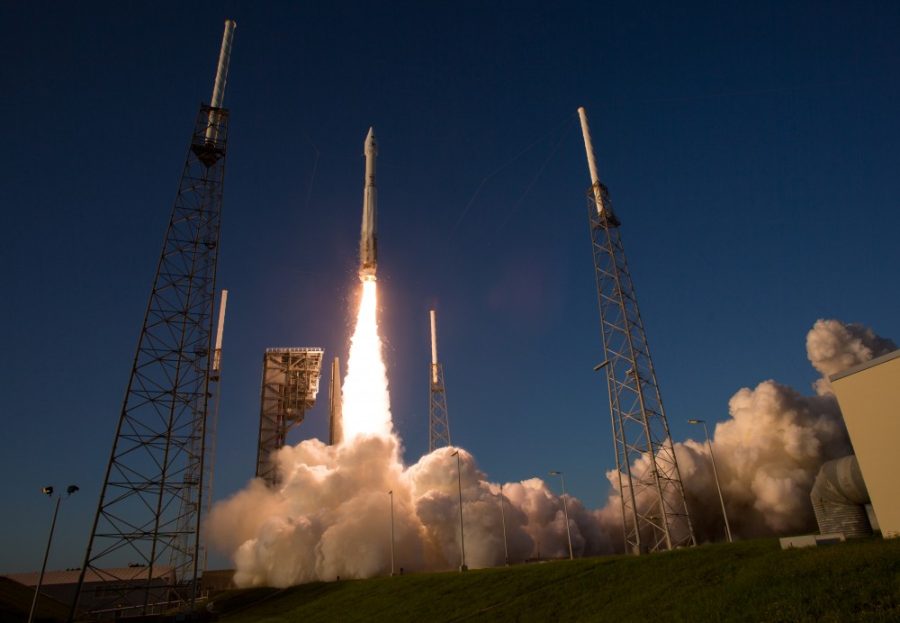On Oct. 20, 2020, the University of Arizona-led OSIRIS-REx mission successfully collected a sample from asteroid Bennu. The OSIRIS-Rex team has made two big decisions since the touch-and-go event.
They decided that on April 7, the OSIRIS-REx mission will have its last glance at asteroid Bennu during the Bennu farewell tour and begin departing for Earth on May 10. This will be their big maneuver where they will fire the main engines on the spacecraft, which they have not used since 2018 when they arrived at the asteroid. This sets them up for retrieving the asteroid sample in Sept. 2023.
They were originally scheduled to leave on March 3, 2021. However, the May 10, 2021 date actually takes less fuel so it will leave more fuel on the spacecraft.
Dante Lauretta, OSIRIS-REx principal investigator and UA professor of planetary science and cosmochemistry, stated, “We are thinking about an extended mission, so we will come back to the earth and drop of the return capsule and then the spacecraft still stays in orbit around the sun.”
From keeping the spacecraft in orbit, they are looking at doing all of the mapping and imaging that they did with Bennu with another asteroid. Another benefit to this is that since they are staying around longer, they can go back to Bennu on their way out.
Lauretta explained that they will be looking at a different kind of asteroid. They are currently looking at their options and where different asteroids are that they could get to.
“Asteroids are classified, and I call it the asteroid alphabet, like Bennu, is a B-type asteroid, so we are looking for other letters in the asteroid alphabet for something that we have never seen before,” Lauretta explained.
During the tour, the team will be taking a collection of images across the surface of asteroid Bennu. Their goal with the images is to look for surface changes that might have occurred as a result of the TAG maneuver.
Dani DellaGiustina, the lead scientist on the mission’s image processing team and senior staff scientist at the UA Lunar and Planetary Laboratory, stated, “a lot of people probably saw the images and gifs that we constructed that follow TAG, and you can see the spray of boulders and dust during that event.”
DellaGiustina explained that they are curious to learn more about what kind of global changes or regional changes could have happened to the surface of Bennu. They will be characterizing that with color images and grayscale images which will be a higher resolution than the colored image data.
Since the TAG maneuver on asteroid Bennu, the team has taken some data of star fields to get a sense of whether or not the camera system had experienced some degradation in the total amount of light that can be put through the system.
“We know that the TAG maneuver kicked up a lot of dust and it seems like some of that got deposited on our camera optics, so we are just trying to characterize the magnitude of that,” DellaGiustina stated.
They are planning for the images they will get from the farewell tour. They are trying to make sure they have really good comparisons for Bennu pre-TAG. They are organizing the data that they have taken in the past, particularly data that they got two years ago. These comparison images will give them a baseline to make an assessment about the surface change.
“My personal prediction is that the surface of Bennu is going to look a little redder than it did before the TAG event,” DellaGiustina said.
The challenges they have faced while preparing for the tour are trying to balance what type of data they will be acquiring. They only get one last look at Bennu so they had to choose carefully with how they use that final look.
The science team is very busy on the ground planning for the sample. They are currently working on building the curation facility, and they are lining up all the different laboratories around the world that will get access to the sample.
Towards the end of April, they will be putting out an image or two that will show what they saw comparing it to what the surface looked like before TAG.
“I am sure there is going to be something that surprises us because that is the nature of this type of work,” DellaGiustina stated.
Follow Jillian Bartsch on Twitter









